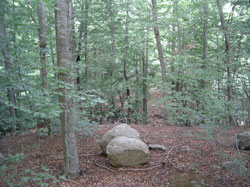Montseny

Relief and geology
Vegetation and climate

The combination of climate, altitude and a mountainous terrain cut by cliffs and streams produces an interesting variety of habitats, and a meeting point for Mediterranean and Central European ecosystems. The slower slopes are dominated by holm oak and other typically Mediterranean species such as stone pine and cork oak, the latter with the remanants of a once thriving cork industry. As one moves up, the holm oak gives way to an association of mountain holm oak and oak. This is then replaced at around 900-1000m by the southernmost beech forests of Europe – bar a couple of small patches in the Sistema Central and Els Ports, massively popular during autumn weekends among Barcelona day trippers for their riot of colours, but reasonanly quiet for most of the year. They also make a welcome break in August from a sweltering Barcelona, but as climate change kicks in, are these woods doomed to disappear? This may already be happening. Studies since 1945 show that holm oak is slowly replacing the beech and that the limit of the beech has moved 70m upwards, in search of cooler, wetter conditions. Turó de l’Home at 1707m is the highest point in Montseny so they’ve got 300 metres to go. More seriously under threat are the sub-alpine communities of the last few hundred metres. Temperatures on Montseny are estimated to have risen by a degree in the last century, double the global average, and leaves here now sprout 20 days earlier than 50 years ago and fall 13 days later. The mountain is said to be undergoing “mediterraneanisation”, and the recent spate of hot summers and dry springs may be speeding this process up. More here (Interview with CSIC researchers).
Wildlife of Montseny

As with the flora, the lower slopes of holm oak the is taken over by Central European fauna as the altidue rises. You have a small fighting chance of seeing wild boar and fox in either of the forest types, and the former’s tracks are omnipresent, but the genet in the holm oak woods and the dormice in the oak woods are much harder to detect. Montseny’s isolation has led to the evoution of the endemic Montseny Brook Newt (Calotriton arnoldi) discovered to science in 2005(+ Video here). This is Spain’s only endemic newt/salamander. Less than 1500 individual adults live in an area of just 40 km2.
Birdlife of Montseny
Montseny is not particularly noted for its birdlife
Human history of Montseny

Montseny has been occupied since prehistoric times. More information in English here. The mountain is also famous for its legends of witches, water maidens and goblins. More information in dodgy English here
Practicalities
Guide books in English about Montseny
Costa Brava: And Barcelona (Landscapes) This walking guide book has a couple of nice walks in Montseny, which I’ve done.
The excellent Spain: Travellers’ Nature Guide has a good chapter on the wildlife and flora of Montseny
Where to stay in Montseny
- The Hotel Sant Bernat boasts a privileged location in the Montseny mountain range at an altitude of 850 metres. An ideal location to relax, set in woodland and gardens, with exceptional views over the surrounding landscape. Completely refurbished hotel, restaurant with hearty and international cuisine, comfortable lounges and large fireplace. Wonderful footpaths: own riding stables, walking, 4×4 excursions. More information
- Hotel Ripoll*** The 4rd. generation of this family run 3 star hotel has renovated it completely in 2006 to offer a service of high quality. The result is 28 en-suite bedrooms decorated in country style and a cosy, informal restaurant offering the specialities of Catalan cuisine. A stay of a few days in Hotel Ripoll can bring you in contact with superb views and walking tracks discovering the Montseny Natural Park (visitors centre 30 minutes). More information
- Husa Monastir Sant Marçal*** The 3 star Husa Monastir Sant Marçal enjoys a privileged location overlooking the Montseny range (850 m high). It offers an intimate atmosphere in every of its corners. The hotel, formerly a 12th century monastery, features spacious lounges with chimneys, a wonderful restaurant and excellent walks in the surroundings. More information
- Hostal de la Gloria*** The “Hostal de la Gloria” Hotel is located at an altitude of 840 m in the town of Viladrau, in the beautiful setting of the Montseny Natural Park. Built in the style of the mountain chalets, it blends perfectly into its natural environment. More information
Walking in Montseny
Good routes here in Catalan

Car
Take A7 mototrway from Barcelona and leave at Sant Celoni, follwing signs for Santa Fe and/or Natural Park de Montseny. Full road map of Montseny here
Train
RENFE: Train skirts eastern side of the park. Take train to xxxx. Get off at el Figaró. Web: www.renfe.es
Barcelonabus. Bus from xxxx at 9:30 am. Get of at Santa Fe for beech woods. Back at 5:30.
Tel. 902 130 014 Web: www.barcelonabus.com
Catalonia
The Iberianature guide to Spain

